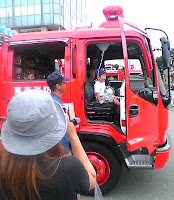Bad Earthquake, But Not That Bad

Bad earthquake this morning near the Hamaoka nuclear reactors that I have written about here and here. Fortunately, reactors 4 and 5 were the only ones up and running, due to the massive debate about the aging first three (ruptures, steam turbine problems and much more). We are told both were shut down, and then there was this line:
Agency officials said they received no reports of radioactivity leakage in surrounding areas.
Many people did get hurt from the usual accidents that always happen. What I don't like is how traffic was stopped on the Tomei Expressway between the Fuji Interchange and the Fukuroi Interchange in Shizuoka Prefecture due to the collapsed section. The artery links Tokyo and Nagoya. Imagine if they wanted to send convoys of fire trucks and other emergency vehicles (ambulances, buses for evacuation purposes) down to Hamaoka. This is clearly not the best place to have five big nuclear reactors - and they are planning to build a new, bigger one, at this very location.
Asahi: Dozens injured in Shizuoka quake
In Japan, many of the country's 50 or so nuclear power plants are getting old and replacing them will be very expensive. To replace the oldest reactors, Chubu Electric Power Co. stated that they would register special losses of about 155 billion yen for the business year ending March 2009, but the company has no clear plan for how to properly dismantle or tear down the old reactors.
Decommissioning work on the old reactors, which are currently not operating, would be completed around 2035, according to The Mainichi on December 13, 2008 (no longer available on their website).
That is more than 25 years from now...
Asahi noted on December 24, 2008 in an editorial (also no longer available) that what is worrisome is that there are no firmly established procedures for shutting down an old reactor:
Decommissioning a 1.1-million-kilowatt reactor produces 500,000 to 550,000 tons of waste. While it contains no high-level radioactive waste, about 3 percent of the matter is polluted with radioactivity. Some sticky questions remain unsolved, such as where the waste materials from the reactor and its peripheral equipment should be buried.
It is vital to work out a viable plan for decommissioning reactors before the nuclear retirement era comes into full swing.
I like Chubu Electric's project to help local residents reduce their electricity consumption. They have been working with local governments and Japan's New Energy and Industrial Technology Development Organization (NEDO) to promote high-efficiency water heaters that conserve energy and reduce CO2 emissions.

(Screen capture from Japan Meteorological Agency, your best source for earthquake updates)
The Hamaoka nuclear reactors in Shizuoka prefecture were supposed to supply Nagoya and Tokyo with electricity.
You can really sense the struggle of the 1960s or the early 1970s mentality here at the Chubu Electric Power website (English): producing as much energy as possible. At least they do give us a hint how difficult it is.
How curious that their main image is a photo of wind power!.




Comments
The answer is at least several hundred if not a few thousand.
Don't get me wrong, I am not in favor of nuclear power plants, but we need to know math if we are to go about replacing them.
IMHO we need to use a lot less energy - and soon - as no amount of wind solar and hydro sources can replace nukes and fossil fuels at this point. It will take a very long time to build such infrastructure and a whole lot of money that no one has now.
So the programs to reduce use should really be the focal point.